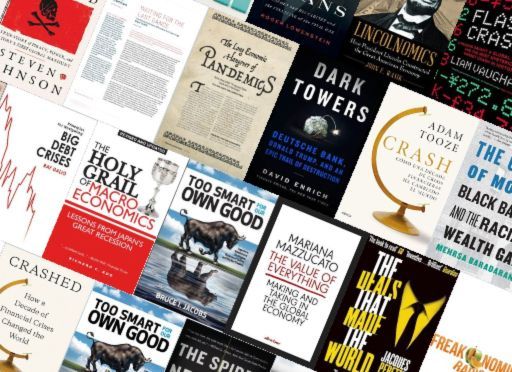Award-winning author and Columbia University history professor Adam Tooze offers a detailed, granular recounting of the 2008 financial crisis.
Calamity and Rescue
On September 15, 2008, New York investment bank Lehman Brothers collapsed. The next day, markets around the world seized. The US Federal Reserve rescued the global economy, writes professor Adam Tooze in this clear, rigorously detailed and exhaustive text. That rescue and the geopolitical changes it wrought have led to an interdependent financial system that, Tooze argues, makes the prospects for coordinated crisis responses all the more unlikely. This impressive work offers readers an overarching and sometimes alarming perspective on the world’s financial future.
Tooze’s layered, far-reaching reportage garnered the Lionel Gerber Prize and recognition as a New York Times Notable Book of 2018, an Economist’s Book of the Year and a New York Times Critics’ Top Book. The Financial Times called this a “monumental narrative history of 10 years that have reshaped our world.” And New York Magazine wrote that Tooze “offers no shortage of penetrating insights into the calamitous epoch we’ve been living through.”
Financial Crisis
Tooze recounts in detail how, on the day after Lehman Brothers failed, the Fed developed emergency plans to prop up the world’s banks. That day, speakers at the United Nations suggested that the crisis derived from the United States’ position as the dominant financial power. Tooze notes that this ready-made explanation blamed the crisis on US budget and trade deficits, and on US reliance on foreign funding, especially from China.
A generation of globalization under the sign of Western power and money had reached its limit.Adam Tooze
Tooze maintains that regarding the United States as the epicenter and cause of the crisis distorts the event’s nature, scope and significance. The global economy is not an “island,” Tooze reminds readers; it’s an “interlocking matrix.”
Deficits
In June 2001, President George W. Bush enacted tax cuts expected to cost the US government $1.35 trillion over 10 years. These decreases, in Tooze’s tally, eliminated surpluses achieved under President Bill Clinton: After the September 11, 2001, terrorist attacks, wars in Afghanistan and Iraq turned the 2000 budget surplus of $86.4 billion into the $568 billion deficit of 2004.
Subprime
Tooze tells how the United States, to encourage homeownership, established agencies like Fannie Mae, which purchased mortgages from banks. Then, Tooze explains, in 1970, Freddie Mac began to buy mortgages granted by savings and loan institutions. By 2008, investment banks had repackaged mortgages into mortgage-backed securities – high-risk instruments through which investors could buy interests in residential and commercial property loans. That booming market, Tooze laments, incentivized lenders to make loans of lesser, or subprime, quality.
The mortgage securitization mechanism systematically produced this race to the bottom in mortgage lending quality.Adam Tooze
Banks, Tooze says, securitized subprime loans that had low chances of repayment, so a huge wave of defaults was inevitable. People lost their homes, mortgage-backed securities collapsed in value and banks that shorted against mass defaults, the author reveals, made money.
The Global Crisis
When financial turmoil spread, Europeans blamed it on irresponsible US capitalism. Yet, Tooze makes clear, international banks had invested in securitized mortgages for years. China was the largest foreign investor, Tooze points out, but Europe dominated in mortgage-backed securities associated with subprime mortgages. By 2010, he notes, the euro zone was suffering its own financial disaster. Tooze finds that neither Americans nor Europeans grasped that the real problem lay with the banks. Trade and commerce, he insists, did not fuel money’s movement around the world; what Tooze calls “credit-fueled booms” caused market imbalances.
Russia and China
Russia provided oil and gas to Europe and Asia, but its banks and companies, as Tooze relates, relied on US and European funds. By 2008, the author reveals, the only nations with larger US dollar reserves than Russia were China and Japan. Globalization fueled by Western money, Tooze stresses, led the international economy to become multipolar.
Feral financial capitalism, like the Iraq war and climate change denial, was part of a toxic Anglo-American variant on modernity.Adam Tooze
Tooze understates wildly when he writes that spending trillions of taxpayer dollars to deliver financial institutions from their own excesses was politically difficult. The debt used to finance troubled US mortgages, Tooze notes, became part of China’s portfolio. Along with the Fed, he asserts, China proved crucial in averting worldwide collapse. In 2008, the United States saved the banks, Tooze states plainly, and it sustained the world’s dollar-based financial architecture.
When Donald Trump became president in 2016, Tooze reports, his erratic behavior made people worry about how his administration might respond to another global financial crisis.
Prescient and Worth Heeding
Adam Tooze is an academic; he writes from the perspective that everyone does, or should, share his fascination with the details of the world financial meltdown. The most likely readers for his granular reporting are those with a vested, day-to-day interest in finance. However, anyone curious about how today’s economic universe came about will learn a great deal, as long as they have the patience to follow Tooze through 700-plus pages that analyze every twist and turn in the saga. Tooze’s skepticism about US willingness to support anything relating to globalism seems prescient and worth heeding.
Adam Tooze’s other books include The Wages of Destruction and The Deluge.




